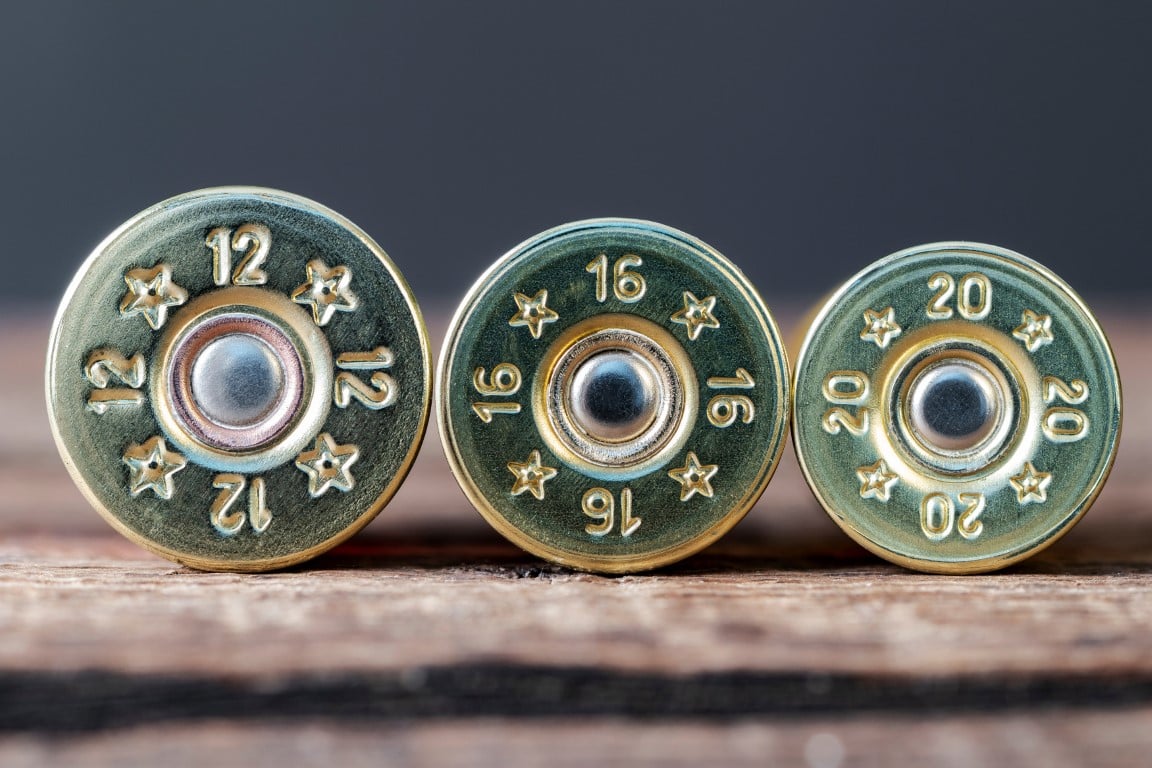One of the first choices you face when you buy a shotgun is which gauge to choose. Unlike rifles, which come in a dizzying selection of calibers, you have only six shotgun “calibers” to choose among: the 10, 12, 16, 20, and 28 gauges, and the .410. Here’s a quick guide to what you need to know about shotgun gauges.
What Is a Gauge?
Shotgun calibers, with one exception, are called “gauges.” Each gauge is named for the number of lead balls that can fit in the gun’s bore diameter that add up to 1 pound. Therefore, the smaller the number, the bigger the bore. The tradition of naming shotgun calibers as gauges stems from the early days of artillery, when cannons were classified according to the weight of the round shot a particular gun fired, such as a “2-pounder” or a “6-pounder.”
The .410 is the one exception in shotgun nomenclature. The term “.410” does refer to the bore diameter of the gun. It would be roughly a 67-gauge, if it were named as the others.
Chamber Length
In addition to gauge, you need to consider chamber length when you choose a gun. Shotgun shells come in different lengths, and the length of the chamber in the barrel’s breech where the shell sits determines how long that shell can be. A gun can fire shells shorter than its chamber length, but not longer.
The larger the gauge, and the longer the hull, the greater the case capacity and the bigger the payload of shot it can hold without generating unsafe pressures. Big gauges shoot more pellets faster, an advantage in shooting at longer ranges. Generally speaking, the smaller the gauge and the shorter the shell, the lighter and trimmer a shotgun chambered for it will be. Smaller shells holding lighter and/or slower payloads kick less than heavier loads but lack their long-range capability.
Here’s rundown of gauges from biggest to smallest.
12 gauge
Bore diameter: .729 inch
Chamber length: 2 ¾, 3, and 3 ½ inches
What it’s best for: Everything. The 12 gauge is by far the most popular gauge in the world, and the most versatile. It can shoot ammunition ranging from very light target loads to magnum shells matching or exceeding 10-gauge levels. Its large bore shoots excellent patterns. Twelve-gauge guns range from very light upland models to 9-pound target guns. It’s the only gauge used in trap shooting and for international clay target games. It’s also the unanimous choice for military and law-enforcement use, and the best for home defense.
What it’s worst for: Some shooters find the 12 gauge bulky and heavy and prefer smaller gauges that are easier for them to handle and shoot.
Bottom line: If you own one shotgun, it should be a 12 gauge chambered for 3-inch shells. It will do everything you need a shotgun to do. The 3½-inch guns give you only a few more yards of effective range at the cost of expense and added recoil.
16 gauge
Bore diameter: .662 inch
Chamber length: 2 ¾ inches
What it’s best for: Upland hunters used to say of the 16 gauge, “It hit like a 12 gauge but carried like a 20 gauge,” and there’s some truth to that. The 16 gauge shoots 1 1/8-ounce loads of shot very well, making it a good choice for upland hunting.
What it’s worst for: Because the 16 gauge only comes in 2¾-inch chambers and not 3-inch, it can’t hold as much steel shot as even a 3-inch 20 gauge can. Although the 16 has come back slightly in recent years, there’s still not a huge variety of ammunition available for it. Also, there are no clay target competitions for the 16, though you could certainly use one for informal trap, skeet, and sporting clays.
Bottom line: If you are a traditionally minded upland bird hunter who wants something different, the 16 is for you.
20 gauge
Bore diameter: .615 inch
Chamber length: 2 ¾ and 3 inches
What it’s best for: Next to the 12, the 20 gauge is the most versatile shotgun gauge. Because it is chambered for 3-inch shells, it can shoot a wide range of shot weights, and 20 gauges are trimmer and usually lighter than 12s, and can have less recoil. They are easier to carry if you’re walking a long way, and make an excellent choice as a first gun or only gun for smaller shooters. It’s a good gauge for skeet and sporting clays, and can be used for home defense, too.
What it’s worst for: You’ll never see a serious trap shooter with a 20 gauge. Also, while 20 gauges are currently a trend among waterfowlers and are enough for short- to medium-range shots, the 20-gauge hull lacks the capacity to hold adequate numbers of very large steel pellets, necessary for shooting geese at long range.
Bottom line: Light to carry and fun to shoot, the 20 gauge can do many of the things a 12 can do, and it’s a good choice for hunters who don’t want to pack the extra weight of the bigger gun. There are lots of 20-gauge guns and shells to choose among, and you can buy them anywhere.
28 gauge
Bore diameter: .550 inch
Chamber length: 2 ¾ or 3 inches
What it’s best for: Light, trim, and soft-kicking, the 28 gauge is a great gauge for upland and dove hunting, when shots don’t exceed 30 yards or so. On the skeet field, the 28 will break targets hard without much recoil, too. The new 3-inch 28s—available only from Benelli right now—turn the 28 gauge into an adequate short-range duck gun. It’s good for beginners or anyone who is recoil-conscious, as long as you can afford the ammo.
What it’s worst for: The biggest disadvantage of the 28 gauge is the price of ammunition, which is much higher than 12- or 20-gauge ammo due to smaller production runs.
Bottom line: It’s a delight to carry and shoot for doves or upland birds, but the ammo is pricey, and the 28 gauge does nothing a 20 gauge can’t do better.
.410 bore
Bore diameter: .410 inch
Chamber length: 2 ½ or 3 inches
What it’s best for: The .410 is best for fun. The tiny .410 shotshell is practically recoilless in very lightweight guns, and there are even revolvers like the Taurus Judge and S&W Governor made for it. It’s a good gun for close-range rabbit and squirrel hunting or pest control, and a very challenging gauge for shooting skeet and sporting clays, both of which offer .410 events. With the introduction of Tungsten Super Shot (TSS) ammunition, the .410 has become a surprisingly effective, popular gauge for turkey hunting.
What it’s worst for: Because it can hold only very light payloads of shot, and because its small bore diameter doesn’t shoot good patterns, the .410 is extremely limited as a gun for serious wingshooting. While it’s often given to young shooters as a first shotgun, it’s really a gun for experts.
Bottom line: By all means get a .410 for fun, for skeet, or, if you’re willing to pay $5 to $6 per shell for TSS, for turkeys. It might be okay as a short-range dove gun, but by and large you should leave the .410 at home when you go bird hunting.
Conclusion
Unlike rifles, which come in a dizzying selection of calibers, you have only six shotgun “calibers” to choose among: the 10, 12, 16, 20, and 28 gauges, and the .410. Of these, the 12 and 20 gauge will appeal to the broadest range of target shooters and hunters.
FAQs
Q: Does a 20 gauge kick less than a 12 gauge?
A: Recoil is a function of the weight of the payload, its velocity as it leaves the gun’s muzzle, and the gun’s weight. Gauge has nothing to do with recoil. However, since a 20-gauge shell for any given purpose is usually lighter and slower than its 12-gauge counterpart, a 20-gauge often will recoil less. By the same token, if you shoot loads of identical weight and velocity out of a 12 gauge and a 20 gauge, the heavier 12 gauge will have lighter recoil. Other factors that affect felt recoil include the softness of the recoil pad and the gun’s action. A gas-operated semi-automatic will have noticeably less kick than a pump, over/under, side-by-side, or inertia-operated semi-automatic.
Q: What is the best gauge for beginners?
A: The best shotgun for a new shooter is a gas-operated semi-automatic in 20 gauge. Gas-operated guns kick noticeably less than any other type of shotgun, and when you combine gas operation with the light payloads of 20-gauge shells and low velocities, you have a gun that won’t kick a new shooter into bad habits, such as flinching and head-lifting. The 28 gauge is a good choice, too, except that ammunition is very expensive. The .410, which is often given to new shooters, makes a poor choice, as extremely light guns are hard to shoot, and the low pellet counts of .410 shells make them difficult to hit targets with. The 20 gauge is an easier gun to hit with.
Q: How do I know what length chamber my shotgun has?
A: Chamber length is typically stamped on the side of the barrel, right after the gun’s gauge. In some older side-by-side and over/under guns, the chamber length will be stamped somewhere on or underneath the gun’s barrels such that you have to take the barrels off to find the stamp. Dropping a shell in the chamber to see if it fits is a poor test, because chamber length refers to the length of a fired shell on which the crimped end has opened to release the shot, not the shorter length of an unfired shell.
Some older guns were made with shorter chambers of 2, 2 ½, and 2 9/16 inches. Some manufacturers offer special short shells for these guns, and sometimes they can be converted by a gunsmith to fire standard, modern ammunition.






